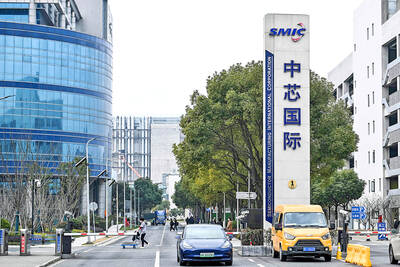China’s GDP would grow an average 4.5 percent over this decade, according to a new forecast by Oxford Economics, meaning China would take longer than other Asian economies, such as Taiwan and South Korea, to catch up with living standards in the developed world.
Annual growth would further slow to about 3 percent on average between 2030 and 2040, according to the baseline forecast by lead economist Adam Slater.
China’s actual economic growth could fall short of that baseline forecast due to worse-than-expected demographic challenges, possible decoupling from the US and allies, mishandling of financial risks or a prolonged real-estate slump, Oxford Economics said in a report.

Photo: EPA-EFE
Other economists have also made similar projections, with Bloomberg Economics forecasting China’s economy would grow at an average pace of 4.6 percent this decade.
The working-age population is likely to continue shrinking according to the forecast, meaning that GDP growth would be reliant on “continued heavy levels of investment and a relatively rapid pace of productivity growth,” the Oxford report said.
China’s productivity growth has already slowed, but would remain high relative to other emerging economies, the baseline forecast showed.
However, trade and especially technological decoupling from China by the US and allies could cut 0.3 to 0.6 percentage points per year from growth by slowing productivity gains, the note added.
The majority of China’s growth over the next decade would be driven by increasing the stock of physical capital, the report said.
China might struggle to maintain its current high levels of physical investment due to rising debt levels, it added.
“Should investment rates start to decrease towards more normal levels, then growth could slump if there is not a dramatic improvement in investment efficiency,” Slater said.
One risk to the forecast comes from China’s real-estate slump, the report said.
“A steep downturn in the sector could have a big negative impact on growth for several years,” it said.
The forecast implies China’s GDP would overtake the US’ in US dollars at current exchange rates by about 2033, Slater said.
However, the baseline forecast suggests the Chinese government would not meet its stated goal of doubling GDP from 2020 levels by 2035, as that would require annual growth averaging about 4.7 percent over that period.

SEMICONDUCTOR SERVICES: A company executive said that Taiwanese firms must think about how to participate in global supply chains and lift their competitiveness Taiwan Semiconductor Manufacturing Co (TSMC, 台積電) yesterday said it expects to launch its first multifunctional service center in Pingtung County in the middle of 2027, in a bid to foster a resilient high-tech facility construction ecosystem. TSMC broached the idea of creating a center two or three years ago when it started building new manufacturing capacity in the US and Japan, the company said. The center, dubbed an “ecosystem park,” would assist local manufacturing facility construction partners to upgrade their capabilities and secure more deals from other global chipmakers such as Intel Corp, Micron Technology Inc and Infineon Technologies AG, TSMC said. It

People walk past advertising for a Syensqo chip at the Semicon Taiwan exhibition in Taipei yesterday.

NO BREAKTHROUGH? More substantial ‘deliverables,’ such as tariff reductions, would likely be saved for a meeting between Trump and Xi later this year, a trade expert said China launched two probes targeting the US semiconductor sector on Saturday ahead of talks between the two nations in Spain this week on trade, national security and the ownership of social media platform TikTok. China’s Ministry of Commerce announced an anti-dumping investigation into certain analog integrated circuits (ICs) imported from the US. The investigation is to target some commodity interface ICs and gate driver ICs, which are commonly made by US companies such as Texas Instruments Inc and ON Semiconductor Corp. The ministry also announced an anti-discrimination probe into US measures against China’s chip sector. US measures such as export curbs and tariffs

The US on Friday penalized two Chinese firms that acquired US chipmaking equipment for China’s top chipmaker, Semiconductor Manufacturing International Corp (SMIC, 中芯國際), including them among 32 entities that were added to the US Department of Commerce’s restricted trade list, a US government posting showed. Twenty-three of the 32 are in China. GMC Semiconductor Technology (Wuxi) Co (吉姆西半導體科技) and Jicun Semiconductor Technology (Shanghai) Co (吉存半導體科技) were placed on the list, formally known as the Entity List, for acquiring equipment for SMIC Northern Integrated Circuit Manufacturing (Beijing) Corp (中芯北方積體電路) and Semiconductor Manufacturing International (Beijing) Corp (中芯北京), the US Federal Register posting said. The